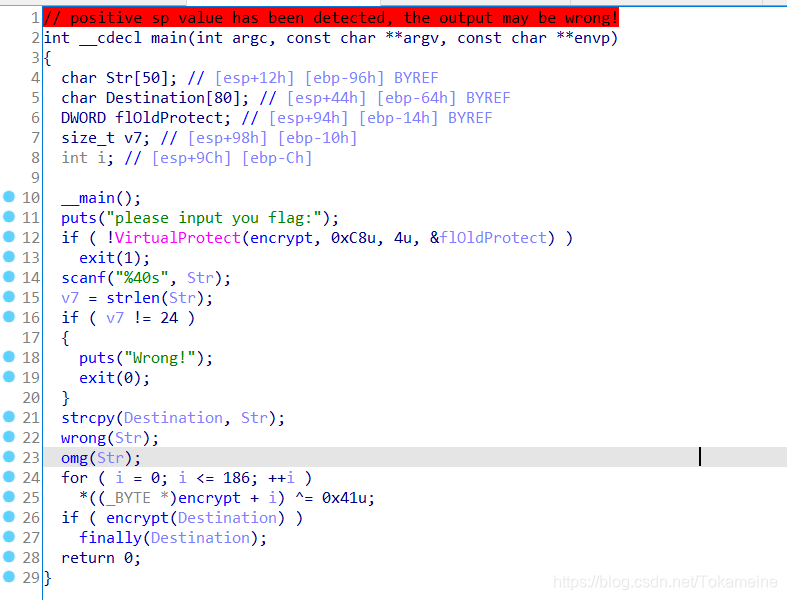无壳,IDA打开可以直接进入main函数:
第12行调用VirtualProtect函数更改了offset encrypt处的访问保护权限
1 2 3 4 5 6 BOOL VirtualProtect(
参见:https://docs.microsoft.com/en-us/windows/win32/memory/memory-protection-constants
该处数据为0x4:PAGE_READWRITE
Enables read-only or read/write access to the committed region of pages. If Data Execution Prevention is enabled, attempting to execute code in the committed region results in an access violation.
简单来说就是让这块数据能够被读写 了(通常text段中只能拥有读/写中的一种 )
继续往下读,发现输入值应该符合 24字节 的长度,然后遇到wrong 和 omg这两个函数
1 2 3 4 5 6 7 8 9 10 11 12 13 14 15 char *__cdecl wrong(char *a1)
1 2 3 4 5 6 7 8 9 10 11 12 13 14 15 16 17 18 19 20 int __cdecl omg(char *a1)
wrong对输入值进行了一些加减或异或处理,然后将结果在omg中同unk_4030C0处数据进行对比;wrong的逆算法容易实现,照抄就行了
(现在才知道能够通过导出窗口快捷的提取出数据,一直以来的手抄实在是太笨了)
1 2 3 4 5 6 7 8 9 10 11 12 13 14 unsigned int k[24] = { 0x66,0x6b,0x63,0x64,0x7f,0x61,0x67,0x64,0x3b,0x56,0x6b,0x61,0x7b,0x26,0x3b,0x50,0x63,0x5f,0x4d,0x5a,0x71,0xc,0x37,0x66 };
得到结果flag{fak3_alw35_sp_me!!},提交发现错误; 由于往下还有关键的encrypt 段没分析,所以不用太怀疑flag是否算错,可以大胆的将它当作一个假的flag
再往下读for循环,发现它对offset encrypt进行了异或,判断其为代码段解密,可以用动调转到这个地方
IDA没能及时更新,需要我们手动修正为函数
选中00401500~0040152F,将其标为代码(Force)
然后在00401502处创建函数,即可得到合适的结果
1 2 3 4 5 6 7 8 9 10 11 12 13 14 15 16 17 18 19 20 // positive sp value has been detected, the output may be wrong!
IDA分析得到的代码并不是那么易读,显然,它将一些索引给翻译错了,但并非无法理解的程度
首先,提取unk_403040处的数据放入(a1-108)处,以及循环中用到的Buffer
1 2 char Buffer[] = "hahahaha_do_you_find_me?";
*(a1-28)实际上是一个索引,指示了这个循环会执行19次;而(*(a1 - 28) + *(a1 + 8))相当于输入值指针加上一个偏移,其内容就是我们的输入值
这个输入值和Buffer异或后的结果应该等于(a1 - 108)的内容,也就是unk_403040处的数据,同样也容易写出解密代码
1 2 3 4 5 6 7 8 char key1[] = "hahahaha_do_you_find_me?";
得到flag{d07abccf8a410c
我们知道,flag应有24字节,但for循环只有19次,也就是缺少了5个字符;由于encrypt函数已经读完了,所以我们需要的结果应该在最后一个函数中,也就是finally函数
将40159A~40159D处的数据全都转为代码,并将函数改为Undefine
重新在40159A处创建函数,得到新函数finally:
1 2 3 4 5 6 7 8 9 10 11 12 13 14 15 16 17 int __cdecl finally(char *a1)
time(0)用以获取当前时间,第10行将其作为种子,第11行获取随机数;大概率我们是难以获取到出题人得到的种子的,因此,这个随机数若是必要的,应该只能通过预测得出
以及下面的if判断条件过于难以理解,不妨试着用OD去动调一下吧(个人觉得OD的动调会更好用一些,也好在这个函数没有被加密,OD还是能分析出来的,否则只能用IDA动调了,虽然没什么差别……)
即便用OD动调也仍然不是很容易能够读懂其意义
关键的比较在401617处,如果相等的话,就说明flag输对了
大致就是取flag的第几位同“**%tp&:**”几位,相等即可;并且这正好是5个字节,很可能就是剩下的flag
但汇编代码中似乎也同样没有相应的加密过程,只能靠猜测它没有被复杂的加密
通过前半段的flag猜测最后一个字符应该为‘}’,将其与“**%tp&:**”的最后一个异或后得到 71,并由此得到最后结果
1 2 3 4 5 6 7 char key2[] = "%tp&:";
我也试着将这个提交成功的flag输入进去,但它仍然不会输出成功的标识,可能是出题人的一点“恶意”吧……最后要靠猜测来得到结果,说实在的,有点难以释然,总觉得是不是自己看漏了什么重要内容……
插画ID:90713460










